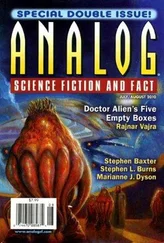“Thus they used the planet’s spin energy to break up its moon.
“They rebuilt the fragments into their habitats, their rocky bubbles. The moonlets would be hurled out of the system, each of them robbing Venus of a little more of its spin. I wonder how long it took — thousands, millions of years? And, as they worked, they waited for Venus to bake itself to death.
“The climate of Venus was destabilized by the spin-down, you see,” Nemoto said. “It got hotter. There must have been a paucity of rain, a terrible drought, at last no rain at all… And finally, the oceans themselves started to evaporate.
“When all the oceans were gone — life must already have been extinguished — the water in the air started to drift to the top of the atmosphere. There, it was broken up by sunlight. The hydrogen escaped to space, and the oxygen and remnant water made sulphuric acid in the clouds.
“And that was what the moonlet builders wanted, you see: the acid. They mined the acid out of the ruined air, perhaps with ships like our profac crawlers.
“It’s an efficient scheme, if you think it over. All you need is a fat, fast-spinning planet with a moon, and you get a source of moonlet ships, a way to launch them, and even a sulphuric acid mine. Venus, despun, was ruined. But they didn’t care. They had what they wanted.
“We are lucky they did not select Earth. Perhaps our Moon was too large, too distant; perhaps the Sun was too far away…”
But they didn’t finish the job, Carole thought. What great catastrophe, eight hundred million years ago, stopped them? Were some of Venus’s great impact craters the wounds left by remnants of that vanished moon falling from the sky, uncontrolled — or even the scars of some disastrous war?
For Venus, Nemoto said, things got worse still. When all its water was lost, plate tectonics halted. The shifting continents seized up, like an engine run out of oil. The planet’s interior heat was trapped, built up — until it was released catastrophically. “Mass volcanism erupted. There were immense lava floods, giant new volcanoes. Much of the surface fractured, crumpled, melted. And the carbon dioxide locked up in the rocks began to pump into the atmosphere, thickening it further…”
Something was moving, directly ahead of her.
It was the beetlelike thing that she had observed from the cliff. And it was working its way along the cable, gouging at it with complex tools she couldn’t make out, scoring it deeply.
It was a gray-black form the size of a small car. It was as tall as she was, its surface featureless, returning glinted highlights of Venus’s complex sky. And it was based on a dodecahedral core.
“Hello,” she said. “You haven’t been here for eight hundred million years.”
“Gaijin technology,” Nemoto whispered when she saw the image. “It is here to scavenge. Carole, this ancient cable is a superconductor, working at Venusian temperatures. Remarkable. Even the Gaijin have nothing like this. And what,” she hissed, “do they intend to do with it? Which of our planets or moons will they wrap up, like a Christmas parcel?”
An alarm chimed softly in Carole’s helmet. She must soon turn back, if she was to complete her long climb back to the lander in safety.
From here she could see the lower plains, the true floor of Venus, the great basalt ocean that covered the planet, still kilometers below her altitude. She longed to go farther, to climb down and explore. But she knew she must not. My mission is over, she realized. Here, at this moment; I have come as far as I can, and must turn back.
She was surprised how disappointed she felt. Earth would seem very confining after this, despite the wealth she expected to claw in from her celebrity. She glanced up at the twisting, pulsing clouds, fifty kilometers up. But no matter how far I travel, she thought, I will always remember this: Venus, where I was first to set foot.
This, and the immense crime I have witnessed here.
“If this happened once, it must have happened again and again,” Nemoto whispered. “A wave of colonists come to a star system like ours. They take what they want, ruinously mining out the resources, trashing what remains. And then they move on… or are somehow stopped. And then, later, when the planets have begun to heal, others follow, and the process begins again. Over and over.
“I predict we will find this everywhere. We can’t assume that anything in the Solar System is truly primordial. We don’t yet know how to look, and the scars will be buried deep in time. But here, it is unmistakable, the mark of their wasteful carelessness…”
Carole stepped carefully behind the blindly toiling Gaijin beetle machine and, peering patiently through the ruddy murk, sought scraps of superconductor.
Chapter 13
The Roads of Empire
Different Suns, a sheaf of worlds: Malenfant drifted among the stars, between flashes of blue teleport light.
It was a strange thought that because the Saddle Point links were so long — in some cases spanning hundreds of light-years, with transit times measured in centuries — there could be whole populations in transit at any moment, stored in Saddle Point transmissions: whole populations existing as frozen patterns of data arrowing between the stars, without thought or feeling, hope or fear.
And he was slowly learning something of the nature of the Saddle Point system itself.
A teleport interstellar transportation system made economic sense — of course, or else it wouldn’t have been built. Saddle Point signals were minimum strength. They seemed to be precisely directed, as if lased, and operated just above the background noise level, worked at frequencies designed to avoid photon quantization noise. And the gateways, of course, were placed at points of gravitational focusing, in order to exploit the billionfold gain available there. He figured, with back-of-the-envelope calculations, that with such savings the cost of information transfer was at least a billion times less than the cost of equivalent physical transfer, by means of ships crawling between the stars.
It was an interstellar transport system designed for creatures like the Gaijin, who relished the cold and dark at the rim of star systems, working at low temperatures and low energies and with virtually no leaked noise. No wonder we had such trouble detecting them, he thought.
But the physics of the system imposed a number of constraints.
Each receiver had to be quantum-entangled with a transmitter. What the builders must have done was to haul receiver gates to the stars by some conventional means, slower-than-light craft like flower-ships. But it was a system with a limited life. Each gate’s stock of entangled states would be depleted every time a teleportation was completed — and so each link could only be used a finite number of times.
Perhaps the builders still existed, and had sustained the motivations that led them to build the gates in the first place, and so were maintaining the gates. If not, the system must be fragmenting, as the key, much-used links ceased to operate. Perhaps the oldest sections had already failed.
It might be that the hubs, the oldest parts of the system, would be inaccessible to humans and Gaijin, the builders isolated, forever unknowable.
He wondered if that was important. It depended on how smart the builders had been, he supposed, how much they understood about what the hell was going on in this cruel universe. He was getting the impression that the Gaijin knew little more than humanity did: that they too were picking their way through this Galaxy of ruins and battle scars, trying to figure out why this kept happening.
Читать дальше
Конец ознакомительного отрывка
Купить книгу











